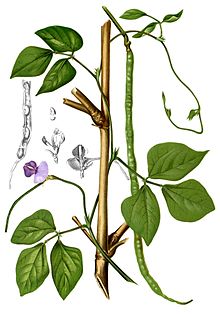| Vigna | |
|---|---|

| |
| Cowpea (Vigna unguiculata) | |
| Scientific classification | |
| Kingdom: | Plantae |
| Clade: | Tracheophytes |
| Clade: | Angiosperms |
| Clade: | Eudicots |
| Clade: | Rosids |
| Order: | Fabales |
| Family: | Fabaceae |
| Subfamily: | Faboideae |
| Clade: | Millettioids |
| Tribe: | Phaseoleae |
| Subtribe: | Phaseolinae |
| Genus: | Vigna Savi (1824), nom. cons. |
| Subgenera | |
| |
| Synonyms[1] | |
| |
Vigna is a genus of plants in the legume family, Fabaceae, with a pantropical distribution.[2] It includes some well-known cultivated species, including many types of beans. Some are former members of the genus Phaseolus. According to Hortus Third, Vigna differs from Phaseolus in biochemistry and pollen structure, and in details of the style and stipules.
Vigna is also commonly confused with the genus Dolichos, but the two differ in stigma structure.[3]
Vigna are herbs or occasionally subshrubs. The leaves are pinnate, divided into 3 leaflets. The inflorescence is a raceme of yellow, blue, or purple pea flowers. The fruit is a legume pod of varying shapes containing seeds.[4]
Familiar food species include the adzuki bean (V. angularis), the black gram (V. mungo), the cowpea (V. unguiculata, including the variety known as the black-eyed pea), and the mung bean (V. radiata). Each of these may be used as a whole bean, a bean paste, or as bean sprouts.
The genus is named after Domenico Vigna, a seventeenth-century Italian botanist and director of the Orto botanico di Pisa.[5]
- ^ Vigna Savi . Plants of the World Online. Retrieved 19 August 2023.
- ^ Aitawade, M. M., et al. (2012). Section Ceratotropis of subgenus Ceratotropis of Vigna (Leguminosae–Papilionoideae) in India with a new species from northern Western Ghats. Archived December 2, 2013, at the Wayback Machine Rheedea 22(1), 20-27.
- ^ Charles Vancouver Piper (1912). Agricultural Varieties of the Cowpea and Immediately Related Species. Bulletin (United States. Bureau of Plant Industry). U.S. Government Printing Office. p. 7.
- ^ Vigna. Flora of China.
- ^ Charters, M. Plant Names T-Z. The Eponym Dictionary of Southern African Plants.